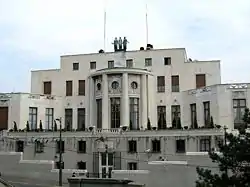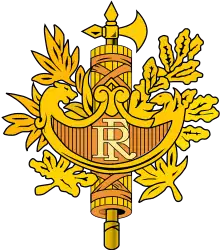Embassy of France, Belgrade
The Embassy of France in Belgrade is the diplomatic representation of the French Republic to the Republic of Serbia and is located in the Serbian capital. Since December 2017 its ambassador is Frédéric Mondoloni.[1]
| Embassy of France | |
|---|---|
Beograd | |
 Embassy of France, Belgrade | |

| |
| General information | |
| Location | Stari Grad, Belgrade |
| Address | 9 Francuska street |
| Country | Serbia |
| Coordinates | 44°49′08″N 20°27′08″E |
| Completed | 1933 |
Embassy
The embassy is between St. Michael's Cathedral, Belgrade and Kalemegdan in Belgrade, overlooking the Danube and the Sava. It hosts the Joint Management Service, the Press Service, the Diplomatic Chancellery, a Consulate, a Military Attaché, and an Internal Security Service.[2]
The building, called "Union", is on the pedestrian street Knez Mihailova. It houses the French Institute of Serbia, the Service of Cooperation, the Economic Mission, and the Regional Center for the Fight Against Organized Crime in Southern Europe.
History
The building was designed by French architect Roger-Henri Expert with Serbian architect Josif Najman as assistant in 1926.[3] At the time it was only the fourth purposely built French embassy, as it was usual to either rent or refurbish an existing building. Construction lasted from 1929 to 1933, with the inauguration night being 21 December 1935. The party had 800 guests, including Milan Stojadinović, and all high ranked government officials led by Prince Paul of Yugoslavia and Princess Olga of Greece and Denmark. The building is a complete work of Art Deco, with everything from the facade, interior, furniture, and lighting in the style.[4]
Exterior
The slope of the site, on the front of two streets, where the building was constructed, represented the real challenge. The architect decided to solve this problem with the massive foundations, which work just like a fortification rather than the ground floor of a modern palace. . Thus, a kind of optical fault has been achieved in an effective way. On a geometrically simply defined object that has a ground floor, two floors and a loft, the middle zone is broken down by a centrally set semicircular shape, and trapezoidal shaped wings. This is also the most expansive zone of the building. On the second floor and attic facade, there is a pyramidal cascade and facade without any decoration, and the viewer's view would be fixed to the bronze group , where the crown dominates the vision of the palace with white facade marble. The style of the building is typical of the inter-war period, modern elements with monumental classicism and refinement of the sculptures.[5] The bronze finial group at the top of building represents Liberté, égalité, fraternité is 2.80m in height and was done by sculptor Charles Marie Louis Joseph Sarrabezolles. He was Experts' friend, known for casting concrete sculptures in innovative way, a method of direct carving in setting concrete, with much of his work was integrated with architecture. Side wings of facade have shallow reliefs that illustrate shortened history of France through Vercingetorix, Joan de Arc, Louis XIV and Marianne.[6]
Interior
The building has five floors, the first two being assigned to the Chancery and the last three to the Residence de France. The vestibule, reached by a large white marble staircase, is decorated with five medallions representing the rivers of France.[7] The original furniture is signed Jules Leleu and Raymond Subes; unfortunately some of the purposely built furniture was either lost or returned to France during WW2.[8]
French ambassadors in Serbia
| De | A | Ambassadeur |
|---|---|---|
| Kingdom of Serbia | ||
| 1907 | 1914 | Léon-Eugène-Aubin Coullard Descos |
| Kingdom of Serbs, Croats and Slovenes | ||
| 1921 | 1922 | Louis Frédéric Clément-Simon |
| Kingdom of Yugoslavia | ||
| 1933 | 1935 | Paul-Émile Naggiar |
| 1936 | 1937 | Robert de Dampierre |
| 1937 | 1940 | Raymond Brugère |
| 1940 | 1940 | Roger Maugras |
| Socialist Federal Republic of Yugoslavia | ||
| 1944 | 1945 | Henry Gauquié[9] |
| 1945 | 1950 | Jean Payart[10] |
| 1950 | 1955 | Philippe Baudet[11] |
| 1955 | 1955 | Camille Coulet[12] |
| 1955 | 1956 | Jean Baelen[13] |
| 1956 | 1962 | Vincent Broustra[14] |
| 1962 | 1965 | Jean Binoche[15] |
| 1965 | 1970 | Pierre Francfort[16] |
| 1970 | 1977 | Pierre Sebilleau[17] |
| 1977 | 1980 | Jacques Martin[18] |
| 1980 | 1982 | Yves Pagniez[19] |
| 1982 | 1985 | Jacques Dupuy[20] |
| 1985 | 1989 | Dominique Charpy[21] |
| 1989 | 1992 | Michel Chatelais[22] |
| Federal Republic of Yugoslavia | ||
| 1992 | 1992 | Alain Rouillard[23] |
| 1996 | 1996 | Gabriel Keller[24] · [25] |
| 1996 | 2000 | Stanislas Filliol[26] |
| 2000 | 2003 | Gabriel Keller[27] · [28] |
| Serbia and Montenegro | ||
| 2003 | 2007 | Hugues Pernet[29] · [30] |
| Serbia | ||
| 2007 | 2010 | Jean-François Terral[31] · [32] |
| 2010 | 2014 | François-Xavier Deniau[33] |
| 2014 | 2017 | Christine Moro |
| 2017 | 2017 | (Christophe Lecourtier) |
| 2017 | Frédéric Mondoloni | |
Diplomatic relations
There has always been a strong relationship between Serbia and France since the Middle Ages, however it was only in the nineteenth century that relations intensified through trade, and official diplomatic relations were established on 18 January 1879,with the opening of both legations.[34]
During the twentieth century, the relationship became more turbulent. The two countries fought together as allies in the First World war, but after the Second World war and the integration of Serbia into Yugoslavia, political relations were toned down. The cultural relationship remained strong however, due to Tito's policy of distance from USSR. Diplomatic relations broke down in the 1990s during the Wars of Yugoslavia when France participated in the bombing of the country.
Diplomatic relations between France and the Federal Republic of Yugoslavia were re-established on 16 November 2000 and were the starting point for a rebuilding of ties between the two. The change of name of the State on 4 February 2003 to the State Union of Serbia and Montenegro did not alter relations between the two countries. The split of Serbia and Montenegro in May 2006 also maintained relations.
Gallery
References
- "L'Ambassadeur Mondoloni a remis ses lettres de créance au Président Vučić". La France en Serbie (in French). Retrieved 17 December 2017.
- "Services – La France en Serbie". rs.ambafrance.org (in French). Retrieved 10 September 2017.
- https://www.academia.edu/21221965/Arhitekt_Josif_Najman_1890-1951_Moment_18_Beograd_1990_100-106
- "Francusko poslanstvo u Beogradu: Ambasador francuskog ukusa". Avant Art Magazin (in Serbian). 11 June 2015. Retrieved 17 April 2019.
- https://www.vesti.rs/Pariz/Zgrada-francuske-ambasade.html
- http://www.politika.rs/sr/clanak/272895/Francuska-ambasada-remek-delo-art-dekoa
- Inventaire de l'Académie d'architecture du fonds Expert, Roger-Henri.
- Béatrice de Rochebouët, " Paris, reine indétronable de l'Art déco ", Le Figaroscope, semaine du 16 au 22 octobre 2013, p. 4-6.
- Délégué du Gouvernement provisoire de la République française
- Ambassadeur
- Décret du 23 septembre 1950, Journal officiel de la République française|JORF du 23 septembre 1950.
- Décret du 4 janvier 1955, JORF du 5 janvier 1955 256.
- Décret du 25 novembre 1955, JORF du 4 décembre 195511744.
- Décret du 3 novembre 1956, JORF du 7 novembre 1956 10624.
- Décret du 31 juillet 1962, JORF du 2 août 1962 7652.
- Décret du 3 novembre 1965, JORF du 4 novembre 1965 9723.
- Décret du 16 mars 1970, JORF du 18 mars 1970 2603.
- Décret du 11 février 1977, JORF du 16 février 1977 934.
- Décret du 4 janvier 1980, JORF du 8 janvier 1980 52.
- Décret du 4 août 1982, JORF du 11 août 1982 2561.
- Décret du 30 avril 1985, JORF du 7 mai 1985 5232.
- Décret du 16 février 1989, JORF 18 février 1989 2326.
- Chargé d'affaires
- Chargé d'affaires puis ambassadeur
- Décret du 11 mars 1996, JORF No. 62 du 13 mars 1996 3887.
- Décret du 17 septembre 1996, JORF No. 220 du 20 septembre 1996 14000.
- Décret du 21 novembre 2000, JORF No. 217 du 21 novembre 2000.
- Ambassadeur auprès de la République fédérale de Yougoslavie.
- Décret du 17 septembre 2003, JORF No. 217 du 19 septembre 2003.
- Ambassadeur auprès de la Communauté étatique de Serbie-et-Monténégro.
- Décret du 4 avril 2007, JORF No. 81 du 5 avril 2007.
- Ambassadeur auprès de la République de Serbie.
- Décret du 25 août 2010, JORF No. 198 du 27 août 2010.
- https://www.vreme.com/cms/view.php?id=757839&print=yes



